
|   |

|   |
 e-mail: ukb7@rediffmail.com The Quintessential Calcutta January 14, 2019 Amidst all the anguish and agony of a troubled daily life, and all the squalor and scampering of an ever-busy pace of city living, the denizens of the eastern metropolis never ignore their utsavs (festivities) and melas (fairs), which seem to anybody caring to observe, as dime a dozen. The current powers-that-be have added an unending string of Public Holidays to bolster up the spirit and there you are, moving from one celebration to another -- all through the year! And yet, the two occasions the enthusiasm and frenzy of enjoyment reach their peaks are: the autumnal Durga Puja and the vernal Yuletide wave, when the lights are set ablaze; the whole city pours out on the amply-lit and copiously-decorated streets and persist on staying out enjoying and merrymaking till the wee hours of the morning! Though not quite at par with the Marghazhi frenzy of Chennai this is quite something that the people ardently look forward to. Here follows a random sampling from the enthusiastic and colorful dance scene this Christmas and New Year Season... The Parv Bharatiyam laid on by the energetic new director Gauri Basu of the Eastern Zonal Cultural Centre - recently resurrected from a supine state! - took off with a scintillating performance by Dona Ganguly and her group. Carefully groomed by Guru Kelucharan Mohapatra, Dona's is a name to reckon with her consummate skills. With a troupe of eleven dancers, she began with Ardhanareeshwara, illustrating how Prakriti, the female attribute of the supreme divinity is indivisible from Purusha, his male attribute. The group compositions - which were the strength of the choreographer - were striking and innovative, for the otherwise well-known theme. The next item, an Arabhi Pallavi, illustrated how a large group of 14 dancers could be imaginatively manipulated for a pure dance number. Dona concentrated on concave arcs dipping towards backstage in the middle and a humdrum Pallavi took wings, in constructing and deconstructing the arc in smaller groups of twos, threes, and sometimes fours with mutually rotating entities, forming rings or simply expanding or contracting helical coils. It was quite arresting visually and aesthetically. She concluded with Durga, an abhinaya item based on the hymn Jatajuta samayuktam..., with five dancers into a front-to-back linearity and displaying the goddess's ten-armed attributes in multiple dynamic postures with Pataka hasta and Ardha pataka mudras, finally slaying the fierce demon. The use of space was well planned and cleverly executed. 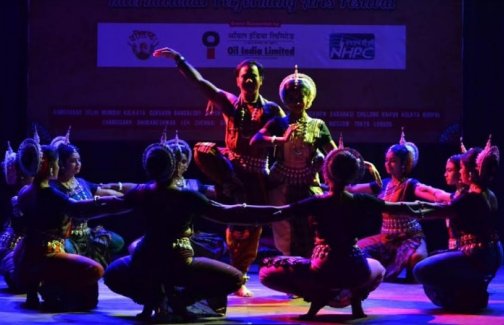 Dona Ganguly and group 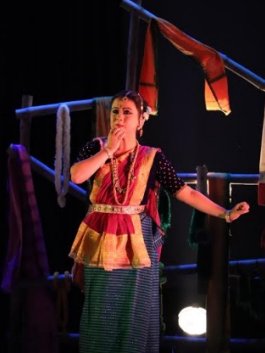 Bimbavati Devi Next, Bimbavati Devi and group took the stage and enacted a charming vignette of incessant rains and the heroine's agony and ecstasy, submerged in the downpours. Called Ghana Baari Barikhata, it was a traditional song rendered in Nata Sankirtana style of Manipur, describing the pangs of a nayika whose tears flow like rainwaters when she sees her nayaka. Says Bimbavati, "Monsoon has been the welcome season of fertility and of love. The monsoon songs eulogize the intermittent separations of the lovers as well as their eternal bonding as they swing together during Jhulan Yatra. There is also a bhakta's devotion for God and the latter's affection for his devotees when his chariot is pulled with the cords of love during Rathayatra....All this happens during the beautiful season of monsoon." Bimbavati's choreography in the true spirit of her father and guru, the iconic Bipin Singh, had the gossamer quality of fleet-footed gait and muted leaps on the stage. Based on the traditional and ritualistic dance-and-song ambience of Manipur, celebrating the monsoon season, her well-groomed dancers etched many patterns and formations in their wide open space in a quality of dancing that was both esoteric and ethereal. With music by N. Tiken Singh and Suman Sarkar, the dancers recapitulated the colorful parakeet, the crescent-breasted cuckoo and the glamorous peacock, before recreating the devotional moods and finally dissolving at the end in a crescendo of ecstatic dance, performed by Tanusree, Ivana, Noel, Baishali, Mousam, Biplab, Rintu and Sony, beside Bimbavati herself. The stage was decorated with traditional Manipuri umbrella, household apparels and an embellishment of natural greenery to provide a scenic Manipuri touch. Antardrishti presented on January 2 by Srjan, the dance research centre founded by guru Kelucharan Mohapatra in Odisha, celebrated their founder's 93rd birth anniversary in Kolkata. As is well known, the centre - founded in 1993 -- is doing exemplary work in teaching, innovating and researching on the Odissi dance form and is nurturing a large number of students over the years, who are continuing to pursue their art in India and abroad. University of North Carolina's Department of Dance, in Charlotte, USA, collaborated with Srjan on this occasion. The evening's program began with Rajashri Praharaj's performing Adi Shankaracharya's well-known composition on Ardhanareeshwara in Ragamalika and Talamalika. With choreography by Kelubabu and music by the renowned singer Raghunath Panigrahi, Rajashri did an excellent job of the great verse, alternating quite well as Shiva and his consort Parvati and used the full stage in her energetic presentation in pristine pure Odissi. The second item was an elaborate Pallavi in Saveri raga and Ekatali by Prachi Hota. She was quite captivating in rendering the well-known item with choreography by Kelubabu and music by Pt. Bhubaneswar Misra. Trained under successive gurus like Arpita Venkatesh, Harekrisna Behera and now Y. Ashakumari, Prachi had a captivating stage presence. The last dancer to appear was Kaustavi Sarkar from UNC Charlotte, USA. She executed the Muslim poet Salabeg's composition Aahe nila saila..., the only lyric of this ardent devotee of Jagannath to have been choreographed by Kelubabu. With great finesse, she depicted the rescue of Gajaraja from the crocodile by Vishnu, the succor lent to Draupadi by Krishna during her ordeal in the Kaurava court, and his own prayer to be provided similar salvation in his own state of leprosy attack. 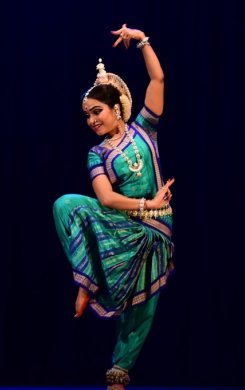 Rajashri Praharaj 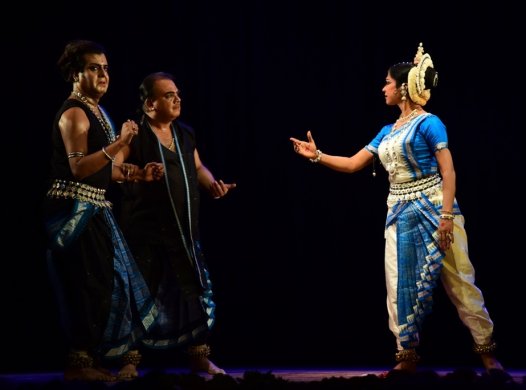 Bali Vadha Bali Vadha was the grand finale, directed by Ratikanta Mohapatra. Based on the Kishkinda Kanda of Tulsidas's Ram Charit Manas, the dance drama depicted - with the melodic chanting of the dohas (couplets) of the celebrated poet -- the epic's many events: Sugriva's (Rajiv Bhatttachaya) friendly overtures to Rama (Sujata Mohapatra) and his narration of his woes in the hands of his brother Bali (Ratikanta Mohapatra) who had abducted his wife Tara; Rama's promise to support Sugriva in his duel with Bali and the blood-soaked duel in which Rama is unable to identify the two brothers wearing the same outfit; Sugriva's recovery under Rama's mercy and now the second duel when the junior ape-king wears a necklace for quick identification; Rama's fatal arrow striking Bali down and the latter's lament to have been killed for having done the sinful deed of kidnapping the brother's wife, and Bali's ultimate redemption, having sought Rama's benevolent mercy. In the production, Rajiv was quietly impressive as the aggrieved younger brother, and Sujata was the picture of dignity as Rama, what with wearing nonchalantly the female costume and continuing her ekaharya abhinaya as Purushottam Rama. Ratikanta's Bali was laudably done, but could have been a little more restrained in its lokadharmi abhinaya. A comment is due on the costume: Bali's and Sugriva's attires were hardly identical, to have justified the story's allusion to Rama's confusion due to dress identity. 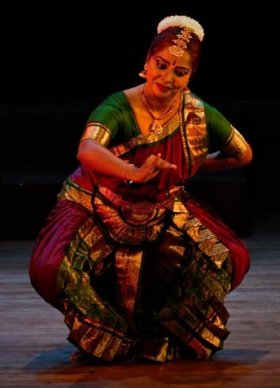 Pancham Veda 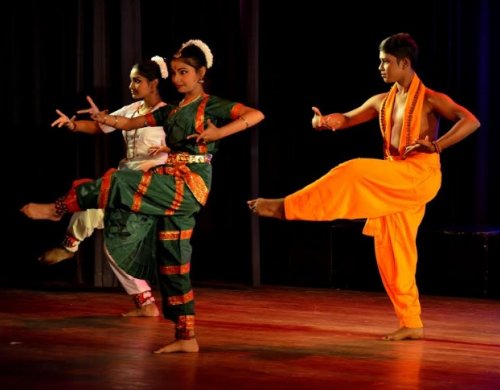 Pancham Veda Pancham Veda presented on January 3 by Chhanda Neerh, was a brave attempt by this classical dance institution keeping its flag aloft for the last 14 years in the distant district town of Medinipur, West Bengal. The centre's laudable given aim of "spreading dance literacy across the state while retaining the purity of the classical dance form" had meant striving relentlessly over the last decade and needs applause. The program began by the centre's director Joyeeta Addya - with a Master's degree in Bharatanatyam from Rabindra Bharati University under her belt and groomed in later years by the renowned guru C.V. Chandrasekhar -- performing a clear-cut Alarippu. This was followed by a spirited Jatiswaram presented as a student-duet, in raga Nattai. Lastly, there was a pleasant abhinaya by Joyeeta based on Tulsidas's Hindi Bhajan, Sri Ramachandra kripalu... in Hamsadhwani raga and mishra chapu tala. Directed and scripted by Joyeeta, the main program Pancham Veda was based on an elaborate take on the origin, evolution and dissemination of dance as contained in the seminal treatise of Bharata's Natya Shastra, known also as Pancham Veda and accepted as the foundation of all dance forms in our land. The mythology visualized a grand spectacle at the end of Satya Yuga when lethal qualities like lust and desire began incarcerating men in Treta Yuga. With a view to saving the waning humanity, Indra prayed to Brahma and the latter recreated the Pancham Veda from the ancient four Vedas, assigning the task of spreading the message of the new Veda to his son Bharata. As the story unfolded, Bharata -- with his one hundred sons and twenty-five Apsaras -- first performed dance at Indra's Dhwajotsava (the Flag Festival) highly appreciated by all present. Later, they also performed in front of Shiva and Parvati and, as suggested by Shiva, Bharata added Karanas and Angaharas into their performance. Shiva and Parvati also asked their attendants Tandu and Usha to spread their dance styles: Tandava and Lasya. The story concluded in the modern age, indicating that ‘Pancham Veda' was rendered by India's classical dances. Music by Shankar Narayanswamy was clearly a strong point of the entire enactment, with original shlokas from Natya Shastra mellifluously recited all through from the initial Namashakram on to Anga Bheda (Shiro Bheda; Hasta Mudra - Asamyukta and Samyukta Hastas; Uro Bheda; Parsva Bheda; Kati Bheda; Pada Bheda),ending with Nritta Hasta and Charis (Bhumi and Akash). Performed earnestly by the students of Chhanda Neerh, where the production faltered was being unable to provide a clearly articulated choreography with enough anga shuddhi on the part of the debutante participants. Not lacking in conceptualisation, the fault lay in the lack of enough mentoring, so that Guru Chandrasekhar's enunciation could reach each petite dancer. Courage, nonetheless, was evident in coming out of a far corner of the state to a mainstream platform and was deserving of every encouragement.  Dr. Utpal K Banerjee is a scholar-commentator on performing arts over last four decades. He has authored 23 books on Indian art and culture, and 10 on Tagore studies. He served IGNCA as National Project Director, was a Tagore Research Scholar and is recipient of Padma Shri. Post your comments Please provide your name and email id when you use the Anonymous profile in the blog to post a comment. All appropriate comments posted with name & email id in the blog will also be featured in the site. |